1、首先,我们先来理一下思路。
正常的接口测试流程是什么?
脑海里的反应是不是这样的:
确定测试接口的工具 —> 配置需要的接口参数 —> 进行测试 —> 检查测试结果(有的需要数据库辅助) —> 生成测试报告(html报告)
那么,我们就根据这样的过程来一步步搭建我们的框架。在这个过程中,我们需要做到业务和数据的分离,这样才能灵活,达到我们写框架的目的。只要好好做,一定可以成功。这也是我当初对自己说的。
接下来,我们来进行结构的划分。
我的结构是这样的,大家可以参考下:
common:存放一些共通的方法
result:执行过程中生成的文件夹,里面存放每次测试的结果
testCase:用于存放具体的测试case
testFile:存放测试过程中用到的文件,包括上传的文件,测试用例以及 数据库的sql语句
caselist:txt文件,配置每次执行的case名称
config:配置一些常量,例如数据库的相关信息,接口的相关信息等
readConfig: 用于读取config配置文件中的内容
runAll:用于执行case
既然整体结构有了划分,接下来就该一步步的填充整个框架了,首先,我们先来看看config.ini和readConfig.py两个文件,从他们入手,个人觉得比较容易走下去哒。
我们来看下文件的内容是什么样子的:
[DATABASE]
host = 50.23.190.57
username = xxxxxx
password = ******
port = 3306
database = databasename[HTTP]
# 接口的url
baseurl = http://xx.xxxx.xx
port = 8080
timeout = 1.0[EMAIL]
mail_host = smtp.163.com
mail_user = xxx@163.com
mail_pass = *********
mail_port = 25
sender = xxx@163.com
receiver = xxxx@qq.com/xxxx@qq.com
subject = python
content = "All interface test has been complited\nplease read the report file about the detile of result in the attachment."
testuser = Someone
on_off = 1相信大家都知道这样的配置文件,没错,所有一成不变的东西,我们都可以放到这里来。哈哈,怎么样,不错吧。现在,我们已经做好了固定的“仓库”。来保存我们平时不动的东西,那么,我们要怎么把它拿出来为我所用呢?这时候,readConfig.py文件出世了,它成功的帮我们解决了这个问题,下面就让我们来一睹它的庐山真面目吧。
import os
import codecs
import configparserproDir = os.path.split(os.path.realpath(__file__))[0]
configPath = os.path.join(proDir, "config.ini")class ReadConfig:def __init__(self):fd = open(configPath)data = fd.read()# remove BOMif data[:3] == codecs.BOM_UTF8:data = data[3:]file = codecs.open(configPath, "w")file.write(data)file.close()fd.close()self.cf = configparser.ConfigParser()self.cf.read(configPath)def get_email(self, name):value = self.cf.get("EMAIL", name)return valuedef get_http(self, name):value = self.cf.get("HTTP", name)return valuedef get_db(self, name):value = self.cf.get("DATABASE", name)return value怎么样,是不是看着很简单啊,我们定义的方法,根据名称取对应的值,是不是so easy?!当然了,这里我们只用到了get方法,还有其他的例如set方法,有兴趣的同学可以自己去探索下,也可以看看小编我自己的关于读取配置文件的博文,这里我们就不在累述了。
话不多说,我们先来看下common到底有哪些东西。
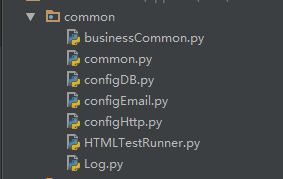
既然配置文件和读取配置文件我们都已经完成了,也看到了common里的内容,接下来就可以写common里的共通方法了,从哪个下手呢?今天,我们就来翻“Log.py”的牌吧,因为它是比较独立的,我们单独跟他打交道,也为了以后它能为我们服务打下良好基础。
这里呢,我想跟大家多说两句,对于这个log文件呢,我给它单独启用了一个线程,这样在整个运行过程中,我们在写log的时候也会比较方便,看名字大家也知道了,这里就是我们对输出的日志的所有操作了,主要是对输出格式的规定,输出等级的定义以及其他一些输出的定义等等。总之,你想对log做的任何事情,都可以放到这里来。我们来看下代码,没有比这个更直接有效的了。
import logging
from datetime import datetime
import threading首先,我们要像上面那样,引入需要的模块,才能进行接下来的操作。
class Log:def __init__(self):global logPath, resultPath, proDirproDir = readConfig.proDirresultPath = os.path.join(proDir, "result")# create result file if it doesn't existif not os.path.exists(resultPath):os.mkdir(resultPath)# defined test result file name by localtimelogPath = os.path.join(resultPath, str(datetime.now().strftime("%Y%m%d%H%M%S")))# create test result file if it doesn't existif not os.path.exists(logPath):os.mkdir(logPath)# defined loggerself.logger = logging.getLogger()# defined log levelself.logger.setLevel(logging.INFO)# defined handlerhandler = logging.FileHandler(os.path.join(logPath, "output.log"))# defined formatterformatter = logging.Formatter('%(asctime)s - %(name)s - %(levelname)s - %(message)s')# defined formatterhandler.setFormatter(formatter)# add handlerself.logger.addHandler(handler),现在,我们创建了上面的Log类,在__init__初始化方法中,我们进行了log的相关初始化操作。具体的操作内容,注释已经写得很清楚了(英文有点儿差,大家看得懂就行,嘿嘿……),这样,log的基本格式已经定义完成了,至于其他的方法,就靠大家自己发挥了,毕竟每个人的需求也不同,我们就只写普遍的共用方法啦。接下来,就是把它放进一个线程内了,请看下面的代码:
class MyLog:log = Nonemutex = threading.Lock()def __init__(self):pass@staticmethoddef get_log():if MyLog.log is None:MyLog.mutex.acquire()MyLog.log = Log()MyLog.mutex.release()return MyLog.log
看起来是不是没有想象中的那样复杂啊,哈哈哈,就是这样简单,python比java简单了许多,这也是我为什么选择它的原因,虽然小编我也是刚刚学习,还有很多不懂的地方。关于python中线程的学习,进行学习哦。希望大家跟我一同进步。好了,至此log的内容也结束了,是不是感觉自己棒棒哒~其实,无论什么时候,都不要感到害怕,要相信“世上无难事只怕有心人”。
下面,我们继续搭建,这次要做的,是configHttp.py的内容。没错,我们开始配置接口文件啦!(终于写到接口了,是不是很开心啊~)
下面是接口文件中主要部分的内容,让我们一起来看看吧。
import requests
import readConfig as readConfig
from common.Log import MyLog as LoglocalReadConfig = readConfig.ReadConfig()class ConfigHttp:def __init__(self):global host, port, timeouthost = localReadConfig.get_http("baseurl")port = localReadConfig.get_http("port")timeout = localReadConfig.get_http("timeout")self.log = Log.get_log()self.logger = self.log.get_logger()self.headers = {}self.params = {}self.data = {}self.url = Noneself.files = {}def set_url(self, url):self.url = host + urldef set_headers(self, header):self.headers = headerdef set_params(self, param):self.params = paramdef set_data(self, data):self.data = datadef set_files(self, file):self.files = file# defined http get methoddef get(self):try:response = requests.get(self.url, params=self.params, headers=self.headers, timeout=float(timeout))# response.raise_for_status()return responseexcept TimeoutError:self.logger.error("Time out!")return None# defined http post methoddef post(self):try:response = requests.post(self.url, headers=self.headers, data=self.data, files=self.files, timeout=float(timeout))# response.raise_for_status()return responseexcept TimeoutError:self.logger.error("Time out!")return None这里我们就挑重点来说吧。首先,可以看到,小编这次是用python自带的requests来进行接口测试的,相信有心的朋友已经看出来了,python+requests这个模式是很好用的,它已经帮我们封装好了测试接口的方法,用起来很方便。这里呢,我就拿get和post两个方法来说吧。(平时用的最多的就是这两个方法了,其他方法,大家可以仿照着自行扩展)
- get方法
接口测试中见到最多的就是get方法和post方法,其中,get方法用于获取接口的测试,说白了,就是说,使用get的接口,都不会对后台数据进行更改,而且get方法在传递参数后,url的格式是这样的:http://接口地址?key1=value1&key2=value2,是不是看起来很眼熟啊~(反正我看着它很眼熟~\(≧▽≦)/~啦啦啦),那我们要怎么使用它呢,请继续往下看。
对于requests提供的get方法,有几个常用的参数:
url:显而易见,就是接口的地址url啦
headers:定制请求头(headers),例如:content-type = application/x-www-form-urlencoded
params:用于传递测试接口所要用的参数,这里我们用python中的字典形式(key:value)进行参数的传递。
timeout:设置接口连接的最大时间(超过该时间会抛出超时错误)
现在,各个参数我们已经知道是什么意思了,剩下的就是往里面填值啦,是不是机械式的应用啊,哈哈,小编我就是这样机械般的学习的啦~
举个栗子:
url=‘http://api.shein.com/v2/member/logout’
header={‘content-type’: application/x-www-form-urlencoded}
param={‘user_id’: 123456,‘email’: 123456@163.com}
timeout=0.5
requests.get(url, headers=header, params=param, timeout=timeout)
- post方法
与get方法类似,只要设置好对应的参数,就可以了。下面就直接举个栗子,直接上代码吧:
url=‘http://api.shein.com/v2/member/login’
header={‘content-type’: application/x-www-form-urlencoded}
data={‘email’: 123456@163.com,‘password’: 123456}
timeout=0.5
requests.post(url, headers=header, data=data, timeout=timeout)
怎么样,是不是也很简单啊。这里我们需要说明一下,post方法中的参数,我们不在使用params进行传递,而是改用data进行传递了。哈哈哈,终于说完啦,下面我们来探(了)讨(解)下接口的返回值。
依然只说常用的返回值的操作。
text:获取接口返回值的文本格式
json():获取接口返回值的json()格式
status_code:返回状态码(成功为:200)
headers:返回完整的请求头信息(headers['name']:返回指定的headers内容)
encoding:返回字符编码格式
url:返回接口的完整url地址
以上这些,就是常用的方法啦,大家可自行取之。
关于失败请求抛出异常,我们可以使用“raise_for_status()”来完成,那么,当我们的请求发生错误时,就会抛出异常。在这里提醒下各位朋友,如果你的接口,在地址不正确的时候,会有相应的错误提示(有时也需要进行测试),这时,千万不能使用这个方法来抛出错误,因为python自己在链接接口时就已经把错误抛出,那么,后面你将无法测试期望的内容。而且程序会直接在这里当掉,以错误来计。(别问我怎么知道的,因为我就是测试的时候发现的)
好了。接口文件也讲完了,是不是感觉离成功不远了呢?嗯,如果各位已经看到了这里,那么恭喜大家,下面还有很长的路要走~哈哈哈,就是这么任性。(毕竟小编我为了让各位和我差不多的小白能够更容易理解,也是使出了体内的洪荒之力啦)
慢慢地长叹一口气,继续下面的内容。。。
快,我想学(看)习(看)common.py里的内容。
import os
from xlrd import open_workbook
from xml.etree import ElementTree as ElementTree
from common.Log import MyLog as LoglocalConfigHttp = configHttp.ConfigHttp()
log = Log.get_log()
logger = log.get_logger()# 从excel文件中读取测试用例
def get_xls(xls_name, sheet_name):cls = []# get xls file's pathxlsPath = os.path.join(proDir, "testFile", xls_name)# open xls filefile = open_workbook(xlsPath)# get sheet by namesheet = file.sheet_by_name(sheet_name)# get one sheet's rowsnrows = sheet.nrowsfor i in range(nrows):if sheet.row_values(i)[0] != u'case_name':cls.append(sheet.row_values(i))return cls# 从xml文件中读取sql语句
database = {}
def set_xml():if len(database) == 0:sql_path = os.path.join(proDir, "testFile", "SQL.xml")tree = ElementTree.parse(sql_path)for db in tree.findall("database"):db_name = db.get("name")# print(db_name)table = {}for tb in db.getchildren():table_name = tb.get("name")# print(table_name)sql = {}for data in tb.getchildren():sql_id = data.get("id")# print(sql_id)sql[sql_id] = data.texttable[table_name] = sqldatabase[db_name] = tabledef get_xml_dict(database_name, table_name):set_xml()database_dict = database.get(database_name).get(table_name)return database_dictdef get_sql(database_name, table_name, sql_id):db = get_xml_dict(database_name, table_name)sql = db.get(sql_id)return sql上面就是我们common的两大主要内容了,什么?还不知道是什么吗?让我告诉你吧。
- 我们利用xml.etree.Element来对xml文件进行操作,然后通过我们自定义的方法,根据传递不同的参数取得不(想)同(要)的值。
- 利用xlrd来操作excel文件,注意啦,我们是用excel文件来管理测试用例的。
听起来会不会有点儿懵,小编刚学时也很懵,看文件就好理解了。
excel文件:

xml文件:
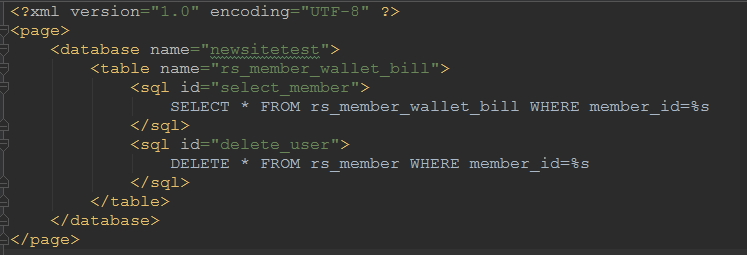
至于具体的方法,我就不再一点点讲解了,总觉得大家都懂(小编刚学,望谅解),只是我个人需要详细记录
接下来,我们看看数据库和发送邮件吧(也可根据需要,不写该部分内容)
先看老朋友“数据库”吧。小编这次使用的是MySQL数据库,所以我们就以它为例吧。
import pymysql
import readConfig as readConfig
from common.Log import MyLog as LoglocalReadConfig = readConfig.ReadConfig()class MyDB:global host, username, password, port, database, confighost = localReadConfig.get_db("host")username = localReadConfig.get_db("username")password = localReadConfig.get_db("password")port = localReadConfig.get_db("port")database = localReadConfig.get_db("database")config = {'host': str(host),'user': username,'passwd': password,'port': int(port),'db': database}def __init__(self):self.log = Log.get_log()self.logger = self.log.get_logger()self.db = Noneself.cursor = Nonedef connectDB(self):try:# connect to DBself.db = pymysql.connect(**config)# create cursorself.cursor = self.db.cursor()print("Connect DB successfully!")except ConnectionError as ex:self.logger.error(str(ex))def executeSQL(self, sql, params):self.connectDB()# executing sqlself.cursor.execute(sql, params)# executing by committing to DBself.db.commit()return self.cursordef get_all(self, cursor):value = cursor.fetchall()return valuedef get_one(self, cursor):value = cursor.fetchone()return valuedef closeDB(self):self.db.close()print("Database closed!")这就是完整的数据库的文件啦。因为小编的需求对数据库的操作不是很复杂,所以这些已基本满足要求啦。注意下啦,在此之前,请朋友们先把pymysql装起来!pymysql装起来!pymysql装起来!(重要的事情说三遍),安装的方法很简单,由于小编是使用pip来管理python包安装的,所以只要进入python安装路径下的pip文件夹下,执行以下命令即可:
pip install pymysql
哈哈哈,这样我们就可以利用python链接数据库啦~(鼓个掌,庆祝下)
小伙伴们发现没,在整个文件中,我们并没有出现具体的变量值哦,为什么呢?没错,因为前面我们写了config.ini文件,所有的数据库配置信息都在这个文件内哦,是不是感觉很方便呢,以后就算变更数据库了,也只要修改config.ini文件的内容就可以了,结合前面测试用例的管理(excel文件),sql语句的存放(xml文件),还有接下来我们要说的,businessCommon.py和存放具体case的文件夹,那么我们就已经将数据和业务分开啦,哈哈哈,想想以后修改测试用例内容,sql语句神马的工作,再也不用每个case都修改,只要改几个固定的文件,是不是顿时开心了呢?(嗯,想笑就大声的笑吧)
回归上面的configDB.py文件,内容很简单,相信大家都能看得懂,就是连接数据库,执行sql,获取结果,最后关闭数据库,没有什么不一样的地方。
该谈谈邮件啦,你是不是也遇到过这样的问题:每次测试完之后,都需要给开发一份测试报告。那么,对于我这样的懒人,是不愿意老是找人家开发的,所以,我就想,每次测试完,我们可以让程序自己给开发人员发一封email,告诉他们,测试已经结束了,并且把测试报告以附件的形式,通过email发送给开发者的邮箱,这样岂不是爽哉!所以,configEmail.py应运而生。当当当当……请看:
import os
import smtplib
from email.mime.multipart import MIMEMultipart
from email.mime.text import MIMEText
from datetime import datetime
import threading
import readConfig as readConfig
from common.Log import MyLog
import zipfile
import globlocalReadConfig = readConfig.ReadConfig()class Email:def __init__(self):global host, user, password, port, sender, title, contenthost = localReadConfig.get_email("mail_host")user = localReadConfig.get_email("mail_user")password = localReadConfig.get_email("mail_pass")port = localReadConfig.get_email("mail_port")sender = localReadConfig.get_email("sender")title = localReadConfig.get_email("subject")content = localReadConfig.get_email("content")self.value = localReadConfig.get_email("receiver")self.receiver = []# get receiver listfor n in str(self.value).split("/"):self.receiver.append(n)# defined email subjectdate = datetime.now().strftime("%Y-%m-%d %H:%M:%S")self.subject = title + " " + dateself.log = MyLog.get_log()self.logger = self.log.get_logger()self.msg = MIMEMultipart('mixed')def config_header(self):self.msg['subject'] = self.subjectself.msg['from'] = senderself.msg['to'] = ";".join(self.receiver)def config_content(self):content_plain = MIMEText(content, 'plain', 'utf-8')self.msg.attach(content_plain)def config_file(self):# if the file content is not null, then config the email fileif self.check_file():reportpath = self.log.get_result_path()zippath = os.path.join(readConfig.proDir, "result", "test.zip")# zip filefiles = glob.glob(reportpath + '\*')f = zipfile.ZipFile(zippath, 'w', zipfile.ZIP_DEFLATED)for file in files:f.write(file)f.close()reportfile = open(zippath, 'rb').read()filehtml = MIMEText(reportfile, 'base64', 'utf-8')filehtml['Content-Type'] = 'application/octet-stream'filehtml['Content-Disposition'] = 'attachment; filename="test.zip"'self.msg.attach(filehtml)def check_file(self):reportpath = self.log.get_report_path()if os.path.isfile(reportpath) and not os.stat(reportpath) == 0:return Trueelse:return Falsedef send_email(self):self.config_header()self.config_content()self.config_file()try:smtp = smtplib.SMTP()smtp.connect(host)smtp.login(user, password)smtp.sendmail(sender, self.receiver, self.msg.as_string())smtp.quit()self.logger.info("The test report has send to developer by email.")except Exception as ex:self.logger.error(str(ex))class MyEmail:email = Nonemutex = threading.Lock()def __init__(self):pass@staticmethoddef get_email():if MyEmail.email is None:MyEmail.mutex.acquire()MyEmail.email = Email()MyEmail.mutex.release()return MyEmail.emailif __name__ == "__main__":email = MyEmail.get_email()这里就是完整的文件内容了,不过可惜的是,小编我遇到一个问题,至今未解,在这里提出,希望大神给出解决办法!跪求啦!
问题:使用163免费邮箱服务器进行邮件的发送,但是,每次发送邮件,都会被163邮件服务器退信,抛出的错误码是:554
官方说明如下:

但是,however,but……小编在整合email进本框架之前写的发送email的小demo是可以正常发送邮件的。这个问题困扰着我,目前仍没有解决,望大神赐教。
离成功不远了,简单说明下HTMLTestRunner.py文件,这个文件呢,也不是小编写的,小编只是它的搬运工,哈哈哈,这个文件是从网上下载的,大神写好的,用于生成html格式的测试报告,什么?想知道生成测试报告的样子?好,这就满足好奇的你:
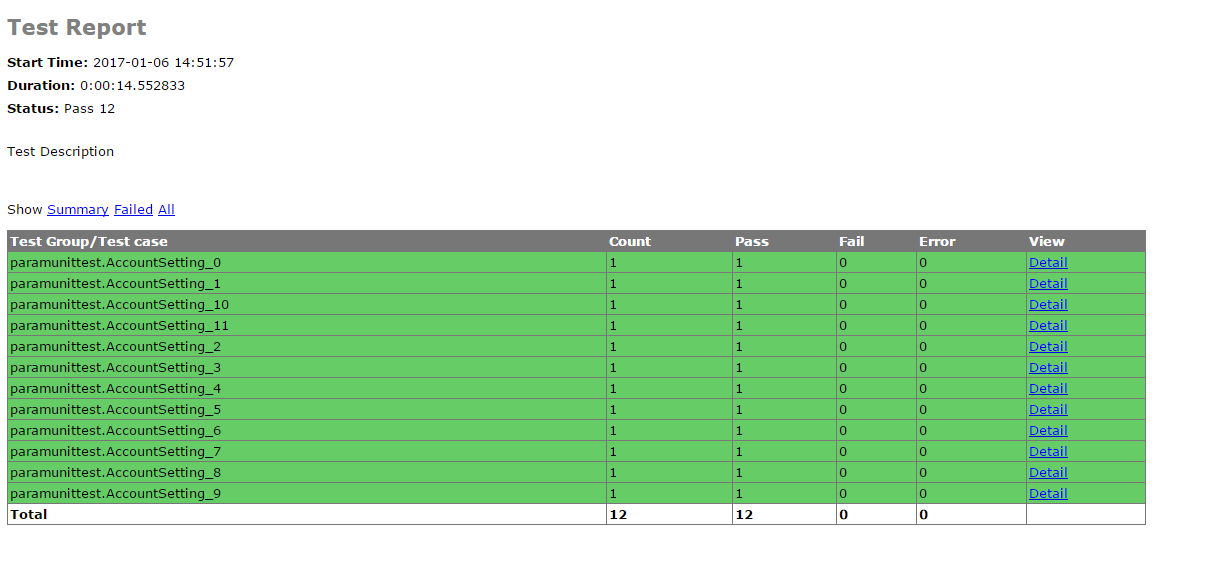
看上去不错吧,嗯,聪明的你们,也可以自己去探索下这个文件,修改修改,变成你自己的style哦~
好了,重头戏来了,就是我们的runAll.py啦。请看主角登场。这是我们整个框架运行的入口,上面内容完成后,这是最后一步啦,写完它,我们的框架就算是完成了。(鼓掌,撒花~)
import unittest
import HTMLTestRunnerdef set_case_list(self):fb = open(self.caseListFile)for value in fb.readlines():data = str(value)if data != '' and not data.startswith("#"):self.caseList.append(data.replace("\n", ""))fb.close()def set_case_suite(self):self.set_case_list()test_suite = unittest.TestSuite()suite_model = []for case in self.caseList:case_file = os.path.join(readConfig.proDir, "testCase")print(case_file)case_name = case.split("/")[-1]print(case_name+".py")discover = unittest.defaultTestLoader.discover(case_file, pattern=case_name + '.py', top_level_dir=None)suite_model.append(discover)if len(suite_model) > 0:for suite in suite_model:for test_name in suite:test_suite.addTest(test_name)else:return Nonereturn test_suitedef run(self):try:suit = self.set_case_suite()if suit is not None:logger.info("********TEST START********")fp = open(resultPath, 'wb')runner = HTMLTestRunner.HTMLTestRunner(stream=fp, title='Test Report', description='Test Description')runner.run(suit)else:logger.info("Have no case to test.")except Exception as ex:logger.error(str(ex))finally:logger.info("*********TEST END*********")# send test report by emailif int(on_off) == 0:self.email.send_email()elif int(on_off) == 1:logger.info("Doesn't send report email to developer.")else:logger.info("Unknow state.")上面我贴出了runAll里面的主要部分,首先我们要从caselist.txt文件中读取需要执行的case名称,然后将他们添加到python自带的unittest测试集中,最后执行run()函数,执行测试集。关于python的unittest,需要学的内容还是很多的
终于呢,整个接口自动化框架已经讲完了,大家是不是看明白了呢?什么?之前的之前贴出的目录结构中的文件还有没说到的?嘿嘿,,,相信不用小编多说,大家也大概知道了,剩下文件夹的作用了。嗯~思索万千,还是决定简单谈谈吧。直接上图,简单明了:

result文件夹会在首次执行case时生成,并且以后的测试结果都会被保存在该文件夹下,同时每次测试的文件夹都是用系统时间命名,里面包含了两个文件,log文件和测试报告。
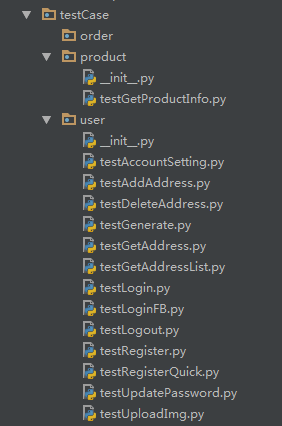
testCase文件夹下,存放我们写的具体的测试case啦,上面这些就是小编写的一些。注意喽,所有的case名称都要以test开头来命名哦,这是因为,unittest在进行测试时会自动匹配testCase文件夹下面所有test开头的.py文件
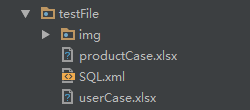
testFile文件夹下,放置我们测试时用来管理测试用例的excel文件和用于数据库查询的sql语句的xml文件哦。
最后就是caselist.txt文件了,就让你们瞄一眼吧:
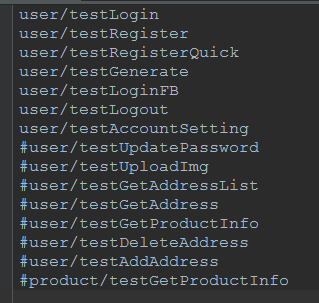
Python接口自动化测试零基础入门到精通(2023最新版)




)









 v10.14.6中文离线安装包)




